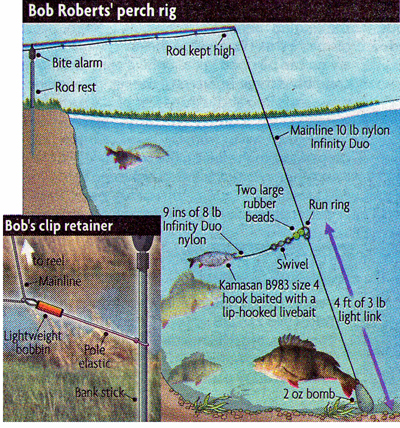 The perch is an enigmatic species. Bold, aggressive, yet exquisitely beautiful. In clear water the colouration of a perch is a delight to behold. You’ll never mistake it for any other species with its rich greens, broad black vertical bars and a creamy belly tipped with bright vermilion fins, but beware the armour plating. Sharp edges to the gill covers and spiky dorsal fin will punish the unwary angler.
The perch is an enigmatic species. Bold, aggressive, yet exquisitely beautiful. In clear water the colouration of a perch is a delight to behold. You’ll never mistake it for any other species with its rich greens, broad black vertical bars and a creamy belly tipped with bright vermilion fins, but beware the armour plating. Sharp edges to the gill covers and spiky dorsal fin will punish the unwary angler.
If you happen to be a small fish then the perch’s beauty will be the last thing on your mind. You’ll be more concerned with its cavernous mouth, an orifice that is comparatively huge to the size of the owner. You’ll also be aware of the sheer speed at which it can attack, but more of that later.
Perch exist everywhere, from tiny farm ponds to lakes, reservoirs, lochs, canals, drains, streams and rivers. We are all familiar with the suicidal packs of small perch that fall so readily to maggot and worms but these are shoal fish. The fish we are looking for are somewhat different. All perch are carnivorous to a degree but some perch rely almost exclusively on a diet of fish from a very young age, certainly through the summer and autumn months. These are the fish that will grow into the specimens we seek.
Contrary to recognised wisdom, the best bait for a big perch is not a minnow or a gudgeon. Yes, you’ll enjoy plenty of action, but you are just as likely to catch a 6-ounce perch as the two-pound plus specimens we’re looking for. Experience on rivers like the Trent and Lower Derwent over the last few seasons has proved pretty conclusively that a roach, dace or chub in the two to 3-ounce range will produce a far better stamp of perch.
Furthermore, you need to be prepared to strike instantly because even a two-pound perch will turn and swallow a livebait in the blink of an eye.
If you think I’m joking, consider this. Last year I lost an absolutely huge perch while stick float fishing for bait. It took a 7-ounce chub! Archie Braddock had a similar experience, again while bait fishing. He was about to lift an 8-ounce perch when it was snatched by a perch similar in size to the one I encountered.
To catch big river perch you obviously have to find them but don’t fall into the obvious trap and go targeting slacks, not at this time of year, anyway.
Big perch like cover. Look for vertical cover like rushes, stakes, steep banks and boat moorings. Horizontal cover like overhanging bushes and lily pads are equally productive features, but wherever you choose to fish make sure there is some flow. I’ve had plenty of good perch from the white water of weirs and encountered too many fish on fast shallows to spend my time in stagnant corners.
Bait presentation is all-important, too. A bait hooked near the dorsal fin will result in a higher percentage of hook-ups on the strike but unfortunately you’ll get less takes due to poor presentation. A lip-hooked livebait works far better and lasts much longer.
Perch like to attack from beneath but that can only happen if your bait is presented close to a feature some three to 4-feet off bottom. This is achieved by tethering a bait in position using a 2-ounce lead and a high rod position. It means the distance you can fish out from the bank is restricted but fear not. We are fortunate that big river perch spend much of their time close to near-bank features.
The downside is that big perch are extremely sensitive to resistance and a taking fish must encounter no sudden resistance, hence the pole elastic line clip retainer shown in the rig diagram. This promotes a steady build-up of pressure before the line is released and results in far less dropped takes.
Perch do not like wire traces, hence the 8lb nylon trace. You can use braid but this tends to result in a few tangles. Pike can be a nuisance and you’ll lose a few when the nylon link is bitten off, but don’t fret too much. The pike will soon rid itself of the barbless hook.
And finally, if you’ve never encountered a really big perch before prepare yourself for a shock. Large predatory perch fight like demons in fast flowing water so don’t say you weren’t warned.
Bob’s Tackle
Rods – Daiwa Powermesh PMS2112B
Reels – Daiwa SSII3000C
Reel Line – Daiwa Infinity Duo – 10lb Test
Hook Link – Daiwa Infinity Duo – 10lb Test
Hooks – Size 4 Kamasan B983
Five Tips
1. Don’t waste your time if the water is coloured after rain
2. Be ready to strike instantly – do not leave a rod unattended
3. Get in close to those features
4. Afternoons tend to be the most consistent feeding time
5. Don’t waste your time with tiny livebaits
Five Big-Perch Rivers
1. River Trent
2. Derbyshire Derwent
3. River Thames
4. River Wye
5. River Severn

